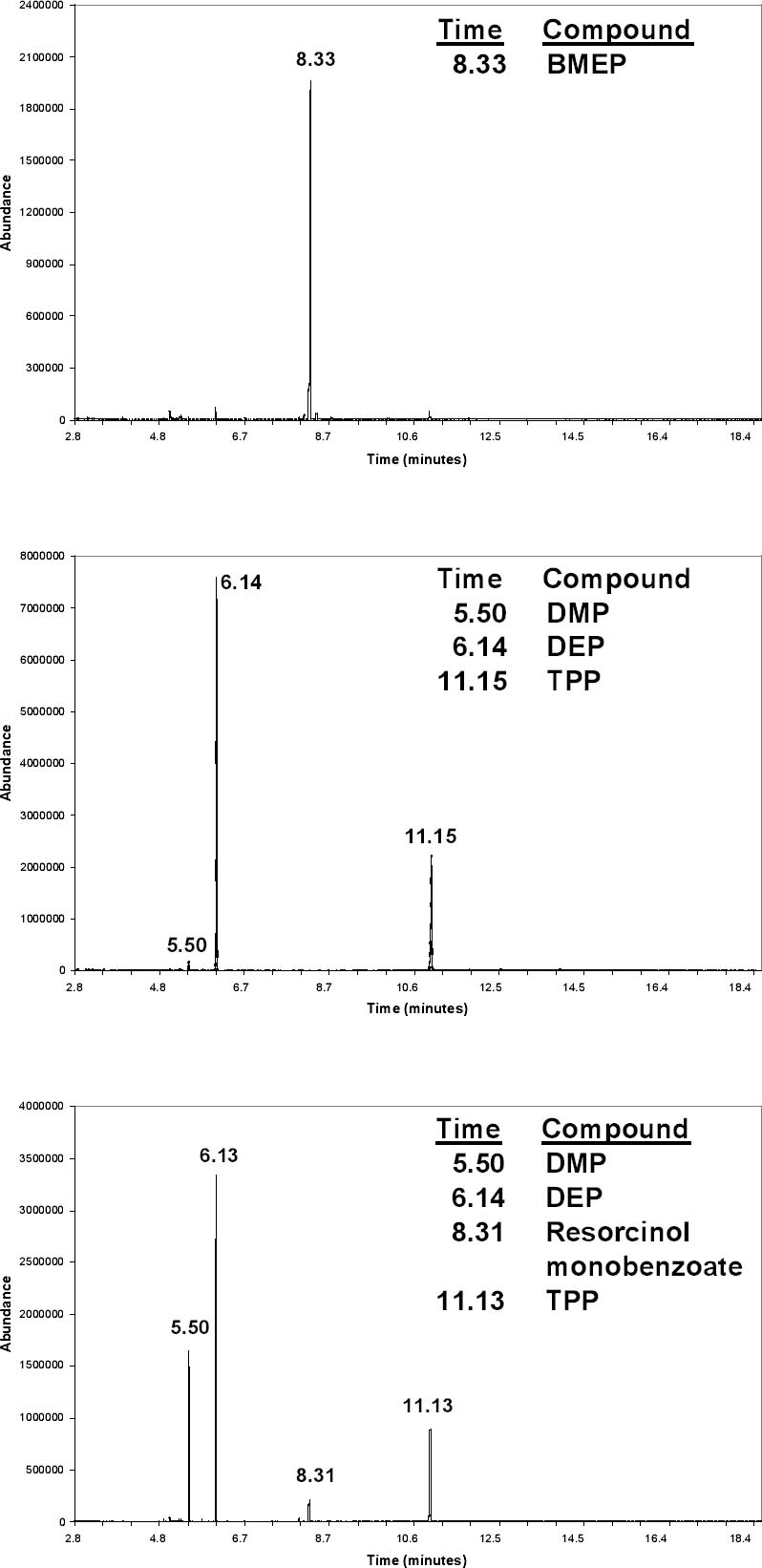ANALYSIS OF LAMINATED DOCUMENTS USING SOLID-PHASE MICROEXTRACTIONMark Ormsby
4 RESULTS AND DISCUSSIONFigure 6 shows the TICs from three lamination films that were sampled by DI-SPME with a PDMS-DVB fiber and an ethanol drop. The upper graph is from a sample of DuPont 88CA48 film that NARA used from the 1940s to 1956. The largest peak was identified as bis(2-methoxyethyl) phthalate (BMEP) based on its retention time and comparison with the spectral library. (With the 1992 edition of the NIST/EPA/NIH database, BMEP and DnBP could not be distinguished. The 2002 version has an additional peak at m/z 59 that dominates the BMEP spectrum.) NBS research showed that BMEP is vulnerable to degradation (Wilson and Forshee 1959a). As a result of these studies, NARA switched to P911 film from Celanese Corporation of America in 1956 and continued using this film into the 1980s (Gear 1965). The middle graph in figure 6 shows a TIC from P911 film. The three largest peaks were identified from their mass spectra as DMP, DEP, and TPP. The bottom graph shows XCA 14672, another film manufactured by Celanese Corporation. It has an additional peak from resorcinol monobenzoate, an ultraviolet absorber recommended in the NBS specifications (Wilson and Forshee 1959b). Thus, figure 6 illustrates that with DI-SPME these three films can be easily and quickly distinguished. Important data about their composition that might be relevant in evaluating their condition and susceptibility to degradation are also gathered. As discussed in the introduction, it might be possible to gather this information by FTIR analysis of various solvent extractions (Haslam and Willis 1965), but such procedures are likely to be more difficult and time consuming. Figure 7 shows the results of HS-SPME from a newspaper laminated in the first run of NARA's presses in 1936. A PDMS-DVB fiber was exposed for 40 minutes using the setup shown in figure 5. The background is noticeably higher compared to the DISPME data, and peaks from the glass beaker are also present. As noted above, the signal-to-noise ratio could be improved by increasing the agitation in the headspace. Along with DMP and DEP, the peak at 8.07 minutes might be a phthalate based on the m/z
A group of documents related to the Louisiana Purchase had been treated and returned to storage at least one year before being analyzed with SPME. As noted in the introduction, it was known that the CA had deteriorated to some degree because water had to be added to the acetone bath in order to delaminate these documents. Scraps of CA had been trimmed from the edges of the film before bathing them. These scraps had been saved and were sampled using a drop of ethanol. As shown in figure 8, DMP, DEP, and DnBP were found. As with the newspaper, there were two other peaks that could not be positively identified. They both had strong signals at m/z 149, which suggests that they are phthalates. A small peak from phthalic anhydride was also found in several CA scraps. It is used to synthesize many phthalates (Wilson 1995), and its presence may indicate that a plasticizer is degrading (Shashoua 2001). In this project phthalic anhydride has been detected only in early CA films from the 1930s or in films that exhibited signs of deterioration. The brand of CA film used on these Louisiana Purchase documents has not yet been identified, but, as can be seen by comparison with figure 6, it is not the 88CA48 film that NARA began using in the 1940s. The degree to which the composition of this early laminating film is related to its deterioration is unclear. This question might be clarified by analyzing other documents laminated at different times and evaluating the solubility of those films. Quantitative measurements of phthalic anhydride hydride, phenol, and other degradation products might also be correlated with the condition of the documents. If successful, it might be possible to use SPME to quickly test a set of laminated documents, evaluate their condition, and identify those most susceptible to deterioration. Such further study will aid in understanding the complex process of CA degradation. Although much accelerated aging research has been published on this topic, it is still difficult to evaluate the role of specific plasticizers. For example, although NBS research showed that BMEP is unstable, an analysis of a laminated document did not reveal the expected breakdown products (Conley 1998). Also, although TPP acts as a stabilizer in cellulose diacetate lamination films (Wilson and Forshee 1959a), it has been shown to play an important role in the degradation of cellulose triacetate photographic film (Shinagawa et al. 1992). Because of differences in materials, aging conditions, and analysis techniques, it is difficult to compare the results of different studies. In addition, a particular plasticizer may have different effects on the initial and secondary degradation reactions (Wilson and Forshee 1959a). Since most lamination films contain mixtures of plasticizers and other additives, the issue is complicated further. To supplement the accelerated aging research, it might be helpful to study some of the vast number of laminated documents that have been stored for decades at ambient conditions. SPME could be used to efficiently analyze the composition and degradation products of a range of documents laminated at different times with different films. Finally, one of the Louisiana Purchase documents was sampled more than one year after it had been delaminated. The data, not shown, were taken on an older GC-MS system using the same type of column but different instrument settings. A PA fiber was placed on the document, covered with the top of a petri dish, and exposed for 75 minutes. DEP was detected as well as other compounds. Thus, analysis by HS-SPME may provide information about previous treatments. Besides lamination, this testing might reveal previous application of volatile pesticides (Ferrari et al. 2004). |
